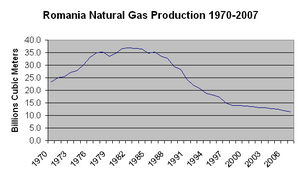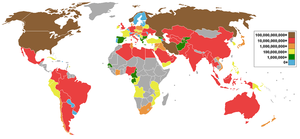Natural gas in Romania

History
On the present-day territory of Romania, the first natural gas deposit was discovered in 1909, in
Production

The local natural gas production is dominated by two very large companies Romgaz with a market share of 51.25% and Petrom with a market share of 46.33%. There are also several smaller companies Aurelian Oil&Gas with a market share of 0.38%, Amromco with a market share of 1.85%, Lotus Petrol with a market share of 0.13% and Wintershall with a market share of 0.06%.[11][12] In 2009 Romania produced around 11 billion cubic meters of natural gas (400 billion cubic feet) which represented 85% of all gas consumed in the country.[12] Romania ranks third in the European Union in terms of natural gas production just after the Netherlands and Germany.[13]
In 2009 the largest natural gas producer in Romania was Romgaz which produced 5.76 billion cubic meters (204 bcft),[14] Petrom came second with around 5 billion cubic meters (177 bcft) and Aurelian Oil&Gas, Amromco, Lotus Petrol and Wintershall produced a combined 0.24 billion cubic meters (8.5 bcft).[14] Around 62.5% of the total natural gas extracted in Romania in 2009 came from the Mureș County.[15]
By 2025 the total natural gas production of Romania will almost double to 18–20 billion cubic meters (638–708 bcft) due to the commissioning of several new natural gas fields found in the continental shelf of the Black Sea.
Future developments
Austria's Petrom and Romania are looking to develop the Neptun Deep gas field in the Black Sea at a cost of €4bn. The field has a potential of 10bn cubic metres per year as of 2027 but was held up in 2023 because of Austria's refusal to agree Romania's entry into the Schengen Area causing ill will between Romania and Austria.[17] According to the Romanian Minister of Energy, Sebastian Burduja, given recent developments, Romania has the opportunity to become the largest gas producer in Europe.[18]
Storage
Romania has eight underground storage facilities with a combined capacity of 3 billion cubic meters (106 bcft).[19] Of the eight, six are operated by Romgaz and two are operated by Depomureș and Amgaz. The Romgaz underground storage facilities have a combined capacity of 2.76 bcm (98 bcft).[20] The storage facilities are located in Sărmășel and Cetatea de Baltă in Transylvania and in Bilciurești, Bălăceanca, Urziceni, and Ghercești in Southern Romania.[20] The largest of the six storages is the Bilciurești facility located 40 km (25 mi) North – North – West of Bucharest having a storage capacity of 1.3 bcm (46 bcft) in one cycle and it is located at a depth of 2,000 m (6,600 ft).[20]
Romgaz also has plans to increase the capacity of its underground storage facilities to around 4 bcm (142 bcft) by 2013.
Reserves
Romania has proven natural gas reserves of 630 billion cubic meters (22.94 Tcf) and is ranked 30th among countries with proved reserves of natural gas..
The largest natural gas field in Romania is the
The natural gas reserves located in the Romanian section of the continental shelf of the Black Sea are estimated at 200 billion cubic meters or 7 trillion cubic feet.[22]
Transmission system

The national
Romania also has four other pipeline links to
References
- ^ a b c "Europe's energy position past & future" (PDF). ec.europa.eu. Archived from the original (PDF) on November 23, 2009. Retrieved September 13, 2010.
- ^ a b "Production" (in Romanian). Romgaz. Retrieved August 20, 2010.
- ^ ISBN 9780891813590. Retrieved 2010-09-13.
- ^ a b "Feasibility study for the enhancement of the Filitelnic gas field, Romania". FBODaily. 2001-11-11. Retrieved 2009-02-24.
- ^ a b "Aurelian tests positive gas flow from onshore Romanian gas discovery". Scandoil. 2009-02-16. Retrieved 2009-02-22.
- ^ a b "Romania – EIII-1 Brodina Block: Exploration". Europa Oil & Gas. 2010. Retrieved 2010-09-07.[permanent dead link]
- ^ a b "International exploration development" (PDF). eia.doe.gov. 1995. Archived from the original (PDF) on 2010-08-06. Retrieved 2010-09-08.
- ^ a b "Gazul natural" (PDF) (in Romanian). BCU Cluj. 2009. Retrieved 2010-08-23.
- ^ a b "100 de ani de la descoperirea si utilizarea gazelor naturale pe teritoriul Romaniei" (in Romanian). Asociatia Generala a Inginerilor din Romania. Archived from the original on July 19, 2011. Retrieved August 20, 2010.
- ^ a b c d "Company Background" (in Romanian). Romgaz. Retrieved August 20, 2010.
- ^ "Raport anual de monitorizare pentru piata interna de gaze naturale – 2009" (in Romanian). ANRE. 2009. Retrieved 2010-09-13.
- ^ a b "Micii producători de gaze naturale din România vor să facă investiții de circa 5 mil. euro în 2010" (in Romanian). money.ro. 2010. Archived from the original on 2013-04-16. Retrieved 2010-09-13.
- ^ "World Mineral Production 2003–2007". British Geological Survey. 2010. Retrieved 2010-09-13.
- ^ a b "Romgaz estimează că producția de gaze va scădea ușor în 2010, la 5,65 miliarde metri cubi". money.ro (in Romanian). Archived from the original on April 16, 2013. Retrieved August 20, 2010.
- ^ "Infrastructură" (in Romanian). Camera de Comerț și Industrie Mureș. 2010. Archived from the original on 2010-03-24. Retrieved 2010-09-13.
- ^ "ANRM: ExxonMobil și OMV Petrom vor extrage 6 miliarde de metri cubi de gaze pe an din Marea Neagră". Capital (in Romanian). 2018. Retrieved 2018-02-21.
- ^ "Romania threatens Black Sea gas project over Austria's Schengen veto". 6 October 2023.
- ^ Arambescu, Dana (September 28, 2023). "România are posibilitatea de a deveni cel mai mare producător de gaz din Europa". Adevărul. Retrieved January 27, 2024.
- ^ a b c "BERD vrea să finanțeze depozite de gaze în România" (in Romanian). Adevărul. 2009. Retrieved 2010-09-13.
- ^ a b c "Storage" (in Romanian). Romgaz. Retrieved August 20, 2010.
- ^ "Memorandumul Romgaz-Gazprom a fost prelungit pana in mai 2011" (in Romanian). Wall Street Journal. 2010. Retrieved 2010-09-13.
- ^ "ANRM: Marea Neagră românească are rezerve de 200 mld. metri cubi de gaze" (in Romanian). Capital. Retrieved February 21, 2018.
- ^ "Infrastructura Sistemului Național de Transport Gaze Naturale (S.N.T.)" (in Romanian). Transgaz. 2010. Archived from the original on 2010-08-05. Retrieved 2010-09-14.
- ^ "Conducta de gaze Arad-Szeged va fi operațională din această lună" (in Romanian). Adevarul. Retrieved August 25, 2010.
- ^ "RWE 'to join Nabucco fold'". upstreamonline.com. 2008-01-22. Retrieved 2010-09-14.
- ^ a b c "Momente semnificative privind istoria gazelor naturale din România" (in Romanian). Transgaz. 2010-09-14. Archived from the original on 2010-08-04. Retrieved 2010-04-13.
- ^ "Romania, Georgia, Azerbaijan sign agreement to build gas terminals". Xinhua. 2010-04-13. Archived from the original on June 9, 2011. Retrieved 2010-04-13.
- ^ "Indicatori tehnici". Transgaz. 2010. Archived from the original on 2010-05-30. Retrieved 2010-04-13.
- ^ "Transgaz va moderniza statia de import gaze Mediesu Aurit cu 1,75 mil. lei" (in Romanian). Wall Street Journal. 2009-11-23. Retrieved 2010-04-14.
- ^ "Departamentul tranzit gaze naturale" (in Romanian). Transgaz. 2010. Archived from the original on 2010-05-30. Retrieved 2010-04-14.
- ^ "Romania castiga 60 mil. euro anual din tranzitul cu gaze". The Wall Street Journal (in Romanian). 2010-06-18. Retrieved 2010-04-14.
